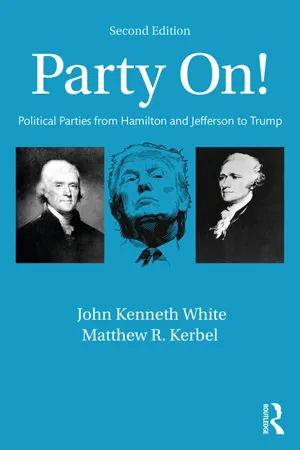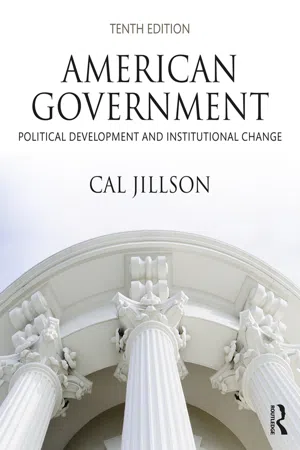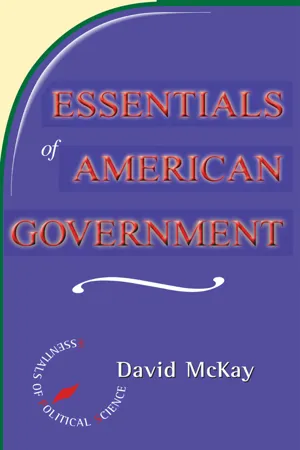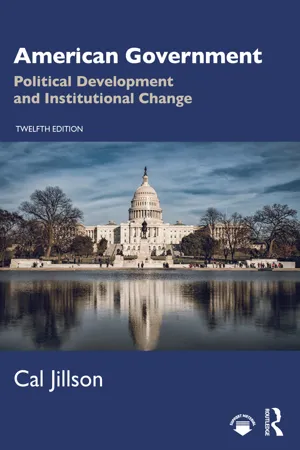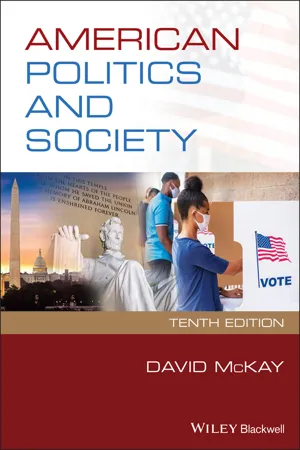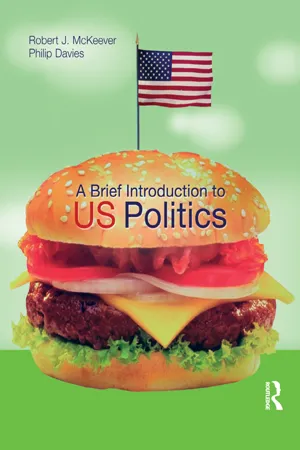History
Rise of Political Parties
The rise of political parties refers to the emergence and growth of organized groups with distinct political ideologies and agendas. This development occurred in response to differing views on governance, policy, and representation, leading to the formation of factions and parties to advocate for specific interests and principles within the political system.
Written by Perlego with AI-assistance
Related key terms
Related key terms
1 of 4
Related key terms
1 of 3
8 Key excerpts on "Rise of Political Parties"
- eBook - ePub
Party On!
Political Parties from Hamilton and Jefferson to Trump
- John White, Matthew Kerbel(Authors)
- 2017(Publication Date)
- Routledge(Publisher)
2The Rise, Fall, and Rebirth of Party Politics
T he most frequently quoted lines in the study of political parties were penned in 1942: “It should be flatly stated,” wrote political scientist E. E. Schattschneider, “that the political parties created democracy and that modern democracy is unthinkable save in terms of parties.”1 Schattschneider’s proclamation is found in nearly every text on political parties written since the 1940s (you just read it here), and most political scientists still accept his assertion as a fact. Yet, to the average citizen, political parties are synonymous with corruption, gridlock, and elitism. Therefore, it should come as no surprise that political parties have had a tortured and tormented history. Although Americans, along with the British, can claim to have invented the modern political party, few take pride in this accomplishment. In 2013, the Gallup Organization found widespread public dislike of both political parties. Pluralities of those polled specifically called out the unwillingness of Democrats and Republicans to compromise and their desire to protect the rich at the expense of the middle class.2 Thus, it should come as no surprise that for more than 200 years, political parties have searched for their rightful place in the American polity without ever quite finding it.The Colonial Experience
Contemporary political parties have their roots in colonial America, where pre-Revolutionary War parties were little more than extensions of rival family clans such as the Wards and Hopkins in Rhode Island and the DeLanceys and Livingstons in New York. The contests between these clans invariably centered on an ideological dispute over the reach of royal authority in the colonies, which began almost as soon as the British ships carrying settlers to Jamestown left port in 1607. On one side were those loyal to the Crown and the appointed royal governors; those opposed were faithful to the elected colonial assemblies. Those supporting the Crown were often wealthy, having received immense land grants from the king, whereas those who did not share these special privileges were tradesmen, small shop owners, and those who tilled the soil and had become accustomed to the hardships of the New World. These poor, adventurous outcasts were suspicious of authority figures, especially the king, and their political cynicism was deep-seated. - eBook - ePub
American Government
Political Development and Institutional Change
- Cal Jillson(Author)
- 2019(Publication Date)
- Routledge(Publisher)
4 Parties as social networks evolve over time, but do not change completely, as new leaders, movements, and issues arise—think of the effect that the “Tea Party” has had on the Republican Party since 2009. The danger, of course, is that parties as social networks become so porous and easily penetrable that they come to stand for little. Donald Trump’s nomination and election have often been described as a “hostile takeover” of the Republican Party that might change the long-standing party brand on issues from national security to trade to taxes, deficits, and debt. As we shall see below, each of these perspectives on American parties provides insights as we look at parties and partisanship in campaigns, elections, and governance.We now turn to the place of parties in the American political system. First, we describe the broad party eras of American political history in terms of the leading figures, principal issues, and relative successes of the major parties during each period. Second, we assess the state of modern political parties in the electorate, as organizations, and in the government. Third, we assess the special role that minor parties play in American politics and how they, together with the interest groups discussed in the previous chapter, relate to and affect the performance of the major parties. Fourth, we ask what changes the future is likely to hold for American political parties and how we can expect parties to respond to those changes. Finally, we ask whether specifics reforms might improve the performance of parties.AP Photo/Matt RourkeParty Eras in American PoliticsMichelle Obama appeared at the Emily’s List gala held in association with the 2008 Democratic National Convention. Emily’s List supports progressive women candidates. This and similar groups represent the “party as social network” idea.Citizens today expect the same things from politics and government that they expected from them two hundred years ago.5 Citizens expect security, opportunity, and progress; they expect that they and their families will be safe and secure, that they will have opportunities to compete fairly for the good things that society has to offer, and that they and their children will be better off over time if they work hard. Political parties compete by offering alternative visions of how government should assist citizens in achieving a better future.As we shall see, a party must do more than win a single election to have the opportunity to implement its vision. A party must win the presidency, both houses of the national Congress, most of the governorships, and majorities in most of the state legislatures, and hold them long enough and by margins large enough to overcome opponents entrenched in the bureaucracies and courts of the land. Only then can a party program be enacted into law and allowed sufficient time to see whether it works as promised.6 - eBook - ePub
- David Mckay(Author)
- 2018(Publication Date)
- Routledge(Publisher)
The constantly impressive ability of American political parties to absorb potentially destabilizing social movements has no doubt contributed to the stability of the system, although the more inquiring mind could note that the two major parties have been able to perform this function only because there have been so few deep divisions in American society. A more divided society could not possibly sustain such a monopoly of power shared by two such amorphous and adaptable parties. This premise is clear when the United States is compared with deeply divided societies such as Northern Ireland or Belgium. In both cases, religious cleavages are such that they are faithfully reflected in the party system.Crisis and Change in the American Party System
At least since the early 1950s, political scientists have bemoaned the decline of American political parties. The “crisis” has been identified mainly in terms of a constant erosion of the five functions just listed. In what is already a highly fragmented political system, the decline of these functions has, so the argument runs, led to inefficient government and to an erosion of the legitimacy of institutions.In order to understand this critique, it is necessary to be familiar with the development of American political parties. Table 5.1 provides a schematic outline of their history by identifying five distinct stages of development. Such a brief summary of the parties’ growth must oversimplify somewhat. In particular, the outline implies that the parties have mobilized different regions and social groups in a coherent way throughout history, but this has never been the case. With the notable exception of the Civil War period, the parties have always represented broad coalitions, and they have almost always eschewed appeals to those class-based ideologies that exploit social divisions in society.Until the early years of the nineteenth century, parties were considered useful only as temporary expedients, or as “factions” necessary to mobilize political power in response to particular crises. As was emphasized in Chapter 3 , the Constitution and the political culture generally in the new republic reflected deep suspicion of political parties and their implied threat of government by factions, tyrannical majorities, and mass political action. Significantly, when mass parties did develop (under the guidance of Andrew Jackson and Martin Van Buren) they did so in a way that largely avoided the dangers foreseen by the founding fathers. The new Democratic Party appealed to broad principles of political equality (at least for white males) rather than to narrow class and sectional interests. It also transformed the party into a highly instrumental - eBook - ePub
American Government
Political Development and Institutional Change
- Cal Jillson(Author)
- 2023(Publication Date)
- Routledge(Publisher)
In 2013, the first election after the strict Texas voter ID law came into effect, both candidates for governor, the Republican Greg Abbott and the Democrat Wendy Davis, were required to cast provisional ballots because the names on their driver’s licenses and on the voter rolls were slightly different. Moreover, this battle has broadened considerably; in the wake of President Trump’s 2020 re-election loss, nineteen states, most under Republican leadership, passed new election laws. Republicans called these voter integrity bills while Democrats called them voter suppression bills.Political Parties in the United States
The founding generation was deeply skeptical of what James Madison called “factions” and what today we call interest groups and political parties. The Founders believed that there was a public interest and a common good and that statesmen might discover and act upon them. Factions, groups, and parties reflected divisions and disagreements within the governing class and perhaps the public about the nature, even the existence, of the common good. Not until the 1830s did Americans begin to consider that the clash of political parties might actually be healthy, even necessary, for democracy.Over the course of the nineteenth century, Americans came to believe that parties could organize, structure, and facilitate democratic politics in ways that made it easier for citizens to participate. Absent parties, voters must study every issue and every candidate independently. But parties have histories, they have reputations as standing for corporate interests or for the common man, and citizens can choose the party that usually represents them best. Choosing a party is easier than studying every issue and every candidate in every election.1The distinguishing characteristic of apolitical partyis that its candidates compete in elections in the hope of winning executive branch offices and majority control of legislatures. Parties recruit and screen candidates, offer platforms, contest elections, and, if they win, attempt to implement their campaign promises. One final and very grave responsibility that parties and party leaders have is managing or protecting their brand.2 The losing party acts as a watchdog, criticizes the governing party, exposes corruption and abuse of power, and prepares for the next election. Contemporary students of political parties have generally agreed with E.E. Schattschneider that modern democratic politics are unthinkable except in terms of parties. Table 7.1 - eBook - ePub
- David McKay(Author)
- 2021(Publication Date)
- Wiley-Blackwell(Publisher)
With three presidential election victories and success in Congress after 1994, there was much talk of a Republican realignment. Although this was true of the South and the mountain states, the west and the north and east remained highly competitive at the state, local and national levels. The Republicans did, however, redefine themselves as the party of low taxes, strong moral or family values, security at home and strength abroad. Ideological polarization greatly increased the electorate’s interest in politics, which showed itself in increased turnout and a much more confrontational and abrasive style of politics. In spite of congressional defeats in 2006 and 2008 and impressive wins by Barack Obama in 2008 and 2012, the Republicans regained control of the House in 2010 and the Senate in 2014. However in 2016, the emergence of Donald Trump as candidate for president confirmed that the party had been captured by the populist right – a trend that continued through to the 2020 presidential and congressional elections. Biden’s victory in 2020 and Democratic control of Congress seemed to herald an end to this period.Until the early years of the 19th century, parties were considered useful only as temporary expedients, or as ‘factions’ necessary to mobilize political power in response to particular crises. As was emphasized in Chapter 3 , the Constitution and the political culture generally in the new republic were deeply suspicious of political parties and their implied threat of government by factions, tyrannical majorities and mass political action. Significantly, when, under the guidance of Andrew Jackson and Martin Van Buren, mass parties did develop, they did so in a way that largely avoided the dangers foreseen by the Founding Fathers. The new Democratic Party appealed to broad principles of political equality (at least for white males) rather than to narrow class and sectional interests. It also transformed the party into a highly instrumental - eBook - ePub
- Robert J. Mckeever(Author)
- 2014(Publication Date)
- Routledge(Publisher)
Chapter 4 Political parties, interest groups and moneyPolitical parties and interest groups are both prominent features of American politics. They differ in key respects. Most obviously parties try to get their candidates elected into office, while interest groups do not have their own candidates and concentrate on influencing whichever party’s candidates are in power. Nevertheless, their functions blur at times and even conflict, particularly when it comes to raising the huge sums of money required to fund election campaigns. In this chapter, we will look at parties, interest groups and campaign finance in turn. We will examine the power of parties and interest groups and the extent to which they enhance or undermine democratic government in the United States.Origins and history of American political partiesAnti-party feeling and the ConstitutionThe Founding Fathers took a dim view of political parties. They regarded parties as selfish factions which sought to use government power to satisfy their own desires while neglecting the legitimate interests of other citizens. If such a faction commanded the support of a majority of citizens, a political party might even institute tyranny. In short, parties were viewed as divisive at a time when the country’s greatest need was unity.Yet by the end of George Washington’s presidency in 1797, the United States possessed its first party system, pitching the Federalists against the Jeffersonian Republicans. In his farewell address, Washington warned the country against ‘the spirit of faction’ that had arisen, but to no avail. In 1800, there occurred the first presidential election fought along clear party lines. What then were the forces which compelled the emergence of political parties?The first party systemFirst, and by far the most important, was the simple fact that Americans were divided by their own self-interests and the public policies linked to them. Although free of the extreme class and ideological divisions of Europe, the United States was not without economic, sectional and political rivalries. Thus, economic activity in the South consisted mainly of agriculture, while that of the Northeast was geared to shipping, banking and commerce. From these differences arose competing views of what constituted good government. - eBook - ePub
- David McKay(Author)
- 2017(Publication Date)
- Wiley-Blackwell(Publisher)
Although this was true of the South and the mountain states, the West and the North and East remained highly competitive at the state, local and national levels. The Republicans did, however, redefine themselves as the party of low taxes, strong moral or family values, security at home and strength abroad. Ideological polarization greatly increased the electorate’s interest in politics, which showed itself in increased turnout and a much more confrontational and abrasive style of politics. In spite of congressional defeats in 2006 and 2008 and impressive wins by Barack Obama in 2008 and 2012, the Republicans regained control of the House in 2010 and the Senate in 2014. However in 2016, the emergence of Donald Trump as candidate for president revealed a deep division in the party between a populist wing and a more traditional or establishment conservative wing. Until the early years of the nineteenth century, parties were considered useful only as temporary expedients, or as ‘factions’ necessary to mobilize political power in response to particular crises. As was emphasized in chapter 3, the Constitution and the political culture generally in the new republic were deeply suspicious of political parties and their implied threat of government by factions, tyrannical majorities and mass political action. Significantly, when, under the guidance of Andrew Jackson and Martin Van Buren, mass parties did develop, they did so in a way which largely avoided the dangers foreseen by the Founding Fathers. The new Democratic Party appealed to broad principles of political equality (at least for white males) rather than to narrow class and sectional interests. It also transformed the party into a highly instrumental organization. For the first time the idea that working for the party could bring specific rewards for the individual became influential. So party membership and loyalty brought with them rewards or political ‘spoils’, of which patronage was the most important - eBook - ePub
The American Political Party System
Continuity and Change Over Ten Presidential Elections
- John S. Jackson(Author)
- 2014(Publication Date)
- Brookings Institution Press(Publisher)
1 The Evolving American Political Party SystemDocumenting and explaining continuity and change is a crucial challenge in the study of American political parties and politics (Schattschneider, 1960; Campbell and others, 1960). This work takes up that challenge with respect to the party system over the last quarter of the twentieth century. The chapter also presents a stocktaking of the condition of the party system at the midpoint of the second decade of the twenty-first century.Ideological Party PolarizationIt is now commonplace to observe that the nation and the parties are deeply polarized, divided into ideologically different and warring camps. That polarization happened over the four decades covered in this study. This book analyzes how and why that polarization took place among party activists and among the mass public. Understanding our political parties is a big step toward understanding where we are and how we got here. Complex organizations, like the two major American political parties, can attempt to preserve the status quo and survive in their traditional patterns, or they can change in the face of new demands. Any complex organization faces the challenge of deciding how much of its public identity, core values, and established patterns to preserve and how much to change in order to survive (Zald, 1970; Zald and Denton, 1963). American political parties and their leadership are no exception to this rule. The basic premise of this book is that political parties—that is, the organizations, the activists who run them, and the party in government—will do what they deem to be necessary to adapt and survive. This organizational imperative animates and disciplines them.American political parties were confronted with tremendous challenges during the last quarter of the twentieth century and through the first decade of the twenty-first century. The ways the parties adapted and changed and the people who led the changes to meet those challenges are the focus of this book. The first three chapters provide a description and analysis of the recent history of the American party system and the major trends in American politics especially regarding presidential elections. The basic proposition explored here is that changing the way we nominate and elect presidents will have a significant impact on political parties and on the entire political system.
Index pages curate the most relevant extracts from our library of academic textbooks. They’ve been created using an in-house natural language model (NLM), each adding context and meaning to key research topics.
Explore more topic indexes
Explore more topic indexes
1 of 6
Explore more topic indexes
1 of 4
